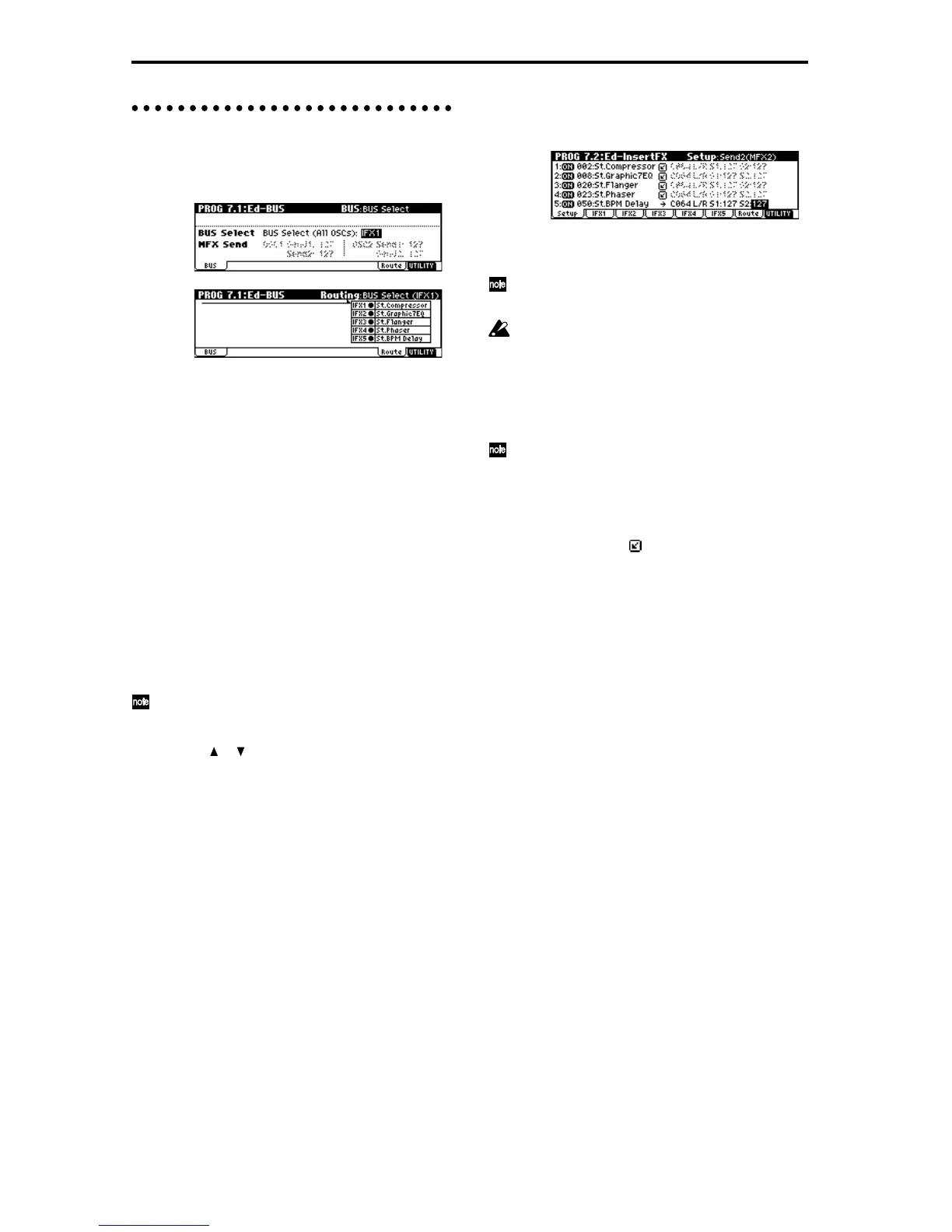98
Effect settings for a program
Routing
1 Select the PROG 7.1: Ed-BUS, BUS page.
2 Use “BUS Select (All OSCs)” to specify the bus
(insertion effect) to which the output of the oscilla-
tor will be sent.
L/R: The output will not be sent to the insert effects.
After passing through the master EQ, the sound will
be sent to AUDIO OUTPUT (MAIN) L/MONO and
R.
IFX1–5: The output will be sent to insert effect IFX 1,
2, 3, 4, or 5.
1, 2, 1/2: The output will be sent to AUDIO OUTPUT
(INDIVIDUAL) 1 or 2. It will not be sent to the insert
effects, the master effects, or the master EQ.
Off: The output will not be sent to AUDIO OUTPUT
(MAIN) L/MONO, R, or to (INDIVIDUAL) 1, 2.
(After passing through the master effects, it will be
output from AUDIO OUTPUT (MAIN).) Select this
when you wish to connect the output to the master
effects in a series connection at the send levels speci-
fied by “MFX Send.”
The Routing page displays the status of routing,
insert effects, and chain settings. In this page you
can also make “BUS Select” settings. Use the
VALUE [ ], [ ] keys, the [VALUE] slider, and
[VALUE] dial to specify the send destination to the
insert effect.
3 “MFX Send” specifies the send level from each
oscillator to the master effects.
This is valid only if “BUS Select (All OSCs)” is set
to L/R or Off.
If IFX1–5 is selected for “BUS Select (All OSCs),” the
send level to the master effects is adjusted by the
“Send 1 (MFX1)” and “Send 2 (MFX2)” parameters
(PROG 7.2: Ed-Insert FX, Setup page) after the sig-
nal has passed through the insert effects.
Insert effects
4 Select the PROG 7.2: Ed-InsertFX, Setup page.
5 For “Insert Effect 1”–“Insert Effect 5,” select the
effect type for each insert effect.
The “Select by Category” utility lets you select
effects from six categories.
Double-size effects 090–102 can be used only for
IFX 2, 3, or 4.
6 Use “On/Off” to switch each insert effect on/off.
A setting of Off will be the same state as when 000:
No Effect is selected. The input sound will be output
without change.
The “Copy Insert Effect” utility lets you copy effect
settings from another program etc. The “Swap
Insert Effect” utility lets you exchange the settings
of two insert effects, such as IFX1 and IFX5.
7 Specify the “Chain” setting.
If you set “Chain” to , insert effects will be con-
nected in series. If you send the oscillator output to
IFX1 as shown in the illustration for step 1 and
make settings as shown in illustration 4, the signal
will be sent in series through the five insert effects
IFX1→IFX2→IFX3→IFX4→IFX5, and will finally be
output.
8 Make settings for “Pan(CC#8),”“BUS Select,” “S1
(Send1(MFX1)),” “S2 (Send2(MFX2))” for the
sound after it has passed through the insert effects.
If the insertion effects are chained, these settings will
apply after the last IFX.
“Pan(CC#8)”: Set the pan. This is valid only when
“BUS Select” is L/R.
“BUS Select”: Specify the output destination. Nor-
mally you will set this to L/R. If you wish to send
the sound that has passed through the insert effects
to AUDIO OUTPUT (INDIVIDUAL) 1, 2, select 1, 2,
or 1/2.
“S1 (Send1(MFX1)),” “S2 (Send2(MFX2))”: Set the
send levels to the master effects. For this example,
set this to 127.
9 Select the IFX1–IFX5 pages, and set the parameters
for each of the selected effects.
For details on the parameters of each effect (
☞PG
p.168–).

